Recent Progress in Improving the Performance of Infrared Photodetectors via Optical Field Manipulations
Abstract
:1. Introduction
2. Infrared Photodetectors Based on Bulk Semiconductors
2.1. InxGa1−xAs NIR and SWIR Photodetectors
2.2. HgxCd1−xTe MWIR and LWIR Photodetector
2.3. Quantum-Well Infrared Photodetectors, Quantum Cascade Photodetectors and Type II Superlattice Photodetectors
2.4. Blocked-Impurity-Band FIR Photodetector
3. Infrared Photodetectors Based on 2D Materials
3.1. Graphene Bolometers
3.2. Metal–Graphene–Metal PDs
3.3. Monolayer and Few-Layer MoS2 PDs
3.4. BP/MoS2 Heterojunction PDs
4. Metasurface-Integrated Compact Photodetectors
4.1. Enhanced Detector Absorption with Metasurfaces
4.2. Metasurfaces Enabled Polarization Detection
4.3. Broadband Response Metalenses Integrated Detection
4.4. Mid-Infrared Multifunctional Compact Metadevices
5. Conclusions and Outlook
Author Contributions
Funding
Data Availability Statement
Conflicts of Interest
References
- Rogalski, A. Infrared detectors: Status and trends. Prog. Quantum Electron. 2003, 27, 59–210. [Google Scholar] [CrossRef]
- Mccarthy, A.; Ren, X.; Della Frera, A.; Gemmell, N.R.; Krichel, N.J.; Scarcella, C.; Ruggeri, A.; Tosi, A.; Buller, G.S. Kilometer-range depth imaging at 1550 nm wavelength using an InGaAs/InP single-photon avalanche diode detector. Opt. Express 2013, 21, 22098–22113. [Google Scholar] [CrossRef] [PubMed] [Green Version]
- Mcchesney, J.J.; Haigh, J.; Dharmadasa, I.M.; Mowthorpe, D.J. Electrochemical growth of GaSb and InSb for applications in infra-red detectors and optical communication systems. Opt. Mater. 1996, 6, 63–67. [Google Scholar] [CrossRef]
- Lazaro, A.; Girbau, D.; Villarino, R. Analysis of vital signs monitoring using an Ir-UWB radar. Prog. Electromagn. Res. 2010, 100, 265–284. [Google Scholar] [CrossRef] [Green Version]
- Bruce, C.; Beichman, C.A.; Buren, D.V.; Gautier, N.; Jorquera, C.R.; Seaman, K.L. Development and test of an IR camera for astronomical observation at the Palomar 200-inch observatory using the NICMOS II array. In Proceedings of the Infrared Technology XVIII, San Diego, CA, USA, 19–22 July 1992; pp. 444–460. [Google Scholar]
- Huang, Z.; Carey, J.E.; Liu, M.; Guo, X.; Mazur, E.; Campbell, J.C. Microstructured silicon photodetector. Appl. Phys. Lett. 2006, 89, 516. [Google Scholar] [CrossRef]
- Martin, T.; Dixon, P.; Gagliardi, M.A.; Masaun, N. 320×240 pixel InGaAs/InP focal plane array for short-wave infrared and isible light imaging. In Proceedings of the Semiconductor Photodetectors II, San Jose, CA, USA, 25–26 January 2005; pp. 85–91. [Google Scholar]
- Miao, Y.; Wang, G.; Kong, Z.; Xu, B.; Zhao, X.; Luo, X.; Lin, H.; Dong, Y.; Lu, B.; Dong, L.; et al. Review of Si-Based GeSn CVD Growth and Optoelectronic Applications. Nanomaterials 2021, 11, 2556. [Google Scholar] [CrossRef] [PubMed]
- Chen, B.; Li, Q.; Chen, J.; Li, G.; Chen, X.; Lu, W. Mechanism of dark current dependence on reverse voltage in mid-wavelength infrared HgCdTe mesa PIN avalanche diode. Opt. Quantum Electron. 2021, 53, 16. [Google Scholar] [CrossRef]
- Zhang, Y.; Ma, W.; Cao, Y.; Huang, J.; Wei, Y. Long wavelength infrared InAs/GaSb superlattice photodetectors with InSb-like and mixed interfaces. IEEE J. Quantum Electron. 2011, 47, 1475–1479. [Google Scholar] [CrossRef]
- Rogalski, A. Quantum well photoconductors in infrared detector technology. J. Appl. Phys. 2003, 93, 4355–4391. [Google Scholar] [CrossRef] [Green Version]
- Delaunay, P.-Y.; Nguyen, B.M.; Hoffman, D.; Huang, E.K.-W.; Razeghi, M. Background Limited Performance of Long Wavelength Infrared Focal Plane Arrays Fabricated From M-Structure InAs–GaSb Superlattices. IEEE J. Quantum Electron. 2009, 45, 157–162. [Google Scholar] [CrossRef]
- Sun, G.; Soref, R.A.; Cheng, H.H. Design of an electrically pumped SiGeSn/GeSn/SiGeSn double-heterostructure midinfrared laser. J. Appl. Phys. 2010, 108, 033107. [Google Scholar] [CrossRef]
- Wirths, S.; Geiger, R.; von den Driesch, N.; Mussler, G.; Stoica, T.; Mantl, S.; Ikonic, Z.; Luysberg, M.; Chiussi, S.; Hartmann, J.M.; et al. Lasing in direct-bandgap GeSn alloy grown on Si. Nat. Photonics 2015, 9, 88–92. [Google Scholar] [CrossRef] [Green Version]
- Alexander, D.H.; Baron, R.; Stafsudd, O.M. Temperature dependence of responsivity in closely compensated extrinsic infrared detectors. IEEE Trans. Electron Devices 1980, 27, 71–77. [Google Scholar] [CrossRef]
- Sclar, N. Properties of doped silicon and germanium infrared detectors. Prog. Quantum Electron. 1984, 9, 149–257. [Google Scholar] [CrossRef]
- Petroff, M.D.; Stapelbroek, M.G. Blocked Impurity Band Detectors. U.S. Patent 4,568,960, 4 February 1986. [Google Scholar]
- Novoselov, K.S.; Geim, A.K.; Morozov, S.V.; Jiang, D.E.; Zhang, Y.; Dubonos, S.V.; Grigorieva, I.V.; Firsov, A.A. Electric field effect in atomically thin carbon films. Science 2004, 306, 666–669. [Google Scholar] [CrossRef] [PubMed] [Green Version]
- Viculis, L.M.; Mack, J.J.; Mayer, O.M.; Hahn, H.T.; Kaner, R.B. Intercalation and exfoliation routes to graphite nanoplatelets. J. Mater. Chem. 2005, 15, 974–978. [Google Scholar] [CrossRef]
- Kaasbjerg, K.; Thygesen, K.S.; Jacobsen, K.W. Phonon-limited mobility in n-type single-layer MoS2 from first principles. Phys. Rev. B 2012, 85, 115317. [Google Scholar] [CrossRef] [Green Version]
- Yu, X.; Yu, P.; Wu, D.; Singh, B.; Zeng, Q.; Lin, H.; Zhou, W.; Lin, J.; Suenaga, K.; Liu, Z.; et al. Atomically thin noble metal dichalcogenide: A broadband mid-infrared semiconductor. Nat. Commun. 2018, 9, 1545. [Google Scholar] [CrossRef]
- Zeng, L.; Wu, D.; Jie, J.; Ren, X.; Hu, X.; Lau, S.P.; Chai, Y.; Tsang, Y.H. Van der Waals Epitaxial Growth of Mosaic-Like 2D Platinum Ditelluride Layers for Room-Temperature Mid-Infrared Photodetection up to 10.6 microm. Adv. Mater. 2020, 32, e2004412. [Google Scholar] [CrossRef]
- Deng, Y.; Luo, Z.; Conrad, N.J.; Liu, H.; Gong, Y.; Najmaei, S.; Ajayan, P.M.; Lou, J.; Xu, X.; Ye, P.D. Black phosphorus–monolayer MoS2 van der Waals heterojunction p–n diode. ACS Nano 2014, 8, 8292–8299. [Google Scholar] [CrossRef] [Green Version]
- Das, S.; Chen, H.Y.; Penumatcha, A.V.; Appenzeller, J. High performance multilayer MoS2 transistors with scandium contacts. Nano Lett. 2013, 13, 100–105. [Google Scholar] [CrossRef]
- Chen, P.; Zhang, T.T.; Zhang, J.; Xiang, J.; Yu, H.; Wu, S.; Lu, X.; Wang, G.; Wen, F.; Liu, Z.; et al. Gate tunable WSe2–BP van der Waals heterojunction devices. Nanoscale 2016, 8, 3254–3258. [Google Scholar] [CrossRef]
- Koppens, F.H.; Mueller, T.; Avouris, P.; Ferrari, A.C.; Vitiello, M.S.; Polini, M. Photodetectors based on graphene, other two-dimensional materials and hybrid systems. Nat. Nanotechnol. 2014, 9, 780–793. [Google Scholar] [CrossRef]
- Dean, C.R.; Young, A.F.; Meric, I.; Lee, C.; Wang, L.; Sorgenfrei, S.; Watanabe, K.; Taniguchi, T.; Kim, P.; Shepard, K.L. Boron nitride substrates for high-quality graphene electronics. Nat. Nanotechnol. 2010, 5, 722–726. [Google Scholar] [CrossRef] [PubMed]
- Liu, H.; Du, Y.; Deng, Y.; Ye, P.D. Semiconducting black phosphorus: Synthesis, transport properties and electronic applications. Chem. Soc. Rev. 2015, 46, 2732–2743. [Google Scholar] [CrossRef] [Green Version]
- Stoller, M.D.; Park, S.; Zhu, Y.; An, J.; Ruoff, R.S. Graphene-based ultracapacitors. Nano Lett. 2008, 8, 3498–3502. [Google Scholar] [CrossRef] [PubMed]
- Balandin, A.A.; Ghosh, S.; Bao, W.; Calizo, I.; Teweldebrhan, D.; Miao, F.; Lau, C.N. Superior thermal conductivity of single-layer graphene. Nano Lett. 2008, 8, 902. [Google Scholar] [CrossRef] [PubMed]
- Lee, J.; Jung, S.; Chen, P.-Y.; Lu, F.; Demmerle, F.; Boehm, G.; Amann, M.-C.; Alù, A.; Belkin, M.A. Ultrafast electrically tunable polaritonic metasurfaces. Adv. Opt. Mater. 2014, 2, 1057–1063. [Google Scholar] [CrossRef]
- Slovick, B.; Zipp, L.; Krishnamurthy, S. Indium phosphide metasurface with enhanced nonlinear absorption. Sci. Rep. 2017, 7, 17245. [Google Scholar] [CrossRef]
- Ghobadi, A.; Ulusoy Ghobadi, T.G.; Karadas, F.; Ozbay, E. Semiconductor thin film based metasurfaces and metamaterials for photovoltaic and photoelectrochemical water splitting applications. Adv. Opt. Mater. 2019, 7, 1900028. [Google Scholar] [CrossRef]
- Howes, A.; Zhu, Z.; Curie, D.; Avila, J.R.; Wheeler, V.D.; Haglund, R.F.; Valentine, J.G. Optical limiting based on Huygens’ metasurfaces. Nano Lett. 2020, 20, 4638–4644. [Google Scholar] [CrossRef] [PubMed]
- Liu, B.; Fischer, R.A. Liquid-phase epitaxy of metal organic framework thin films. Sci. China Chem. 2011, 54, 1851–1866. [Google Scholar] [CrossRef]
- Biefeld, R.M. The metal-organic chemical vapor deposition and properties of III-V antimony-based semiconductor materials. Mater. Sci. Eng. R-Rep. 2002, 36, 105–142. [Google Scholar] [CrossRef]
- Joyce, B.A. Molecular beam epitaxy. Rep. Prog. Phys. 1985, 48, 1637–1697. [Google Scholar] [CrossRef]
- Rogalski, A.; Larkowski, W. Comparison of photodiodes for the 3–5.5 μm and 8–14 μm spectral regions. Electron Technol. 1985, 18, 55–69. [Google Scholar]
- Vurgaftman, I.; Meyer, J.R.; Ram-Mohan, L.R. Band parameters for III–V compound semiconductors and their alloys. J. Appl. Phys. 2001, 89, 5815–5875. [Google Scholar] [CrossRef] [Green Version]
- Gong, H.M.; Tang, H.J.; Li, X.; Zhang, K.F.; Li, Y.F.; Li, T.; Ning, J.H.; Wang, Y.; Miao, G.Q.; Song, H.; et al. Near-infrared InGaAs FPAs for space applications. Infrared Laser Eng. 2009, 38, 575–582. [Google Scholar]
- Arslan, Y.; Oguz, F.; Besikci, C. Extended wavelength SWIR InGaAs focal plane array: Characteristics and limitations. Infrared Phys. Technol. 2015, 70, 134–137. [Google Scholar] [CrossRef]
- Leite, M.S.; Woo, R.L.; Munday, J.N.; Hong, W.D.; Mesropian, S.; Law, D.C.; Atwater, H.A. Towards an optimized all lattice-matched InAlAs/InGaAsP/InGaAs multijunction solar cell with efficiency >50%. Appl. Phys. Lett. 2013, 102, 033901. [Google Scholar] [CrossRef] [Green Version]
- Yuan, H.; Meixell, M.; Zhang, J.; Bey, P.; Kimchi, J.; Kilmer, L.C.; Andresen, B.R.F.; Fulop, G.F.; Norton, P.R. Low dark current small pixel large format InGaAs 2D photodetector array development at Teledyne Judson Technologies. In Proceedings of the Infrared Technology & Applications XXXVIII, Baltimore, MD, USA, 23–27 April 2012; p. 835309. [Google Scholar]
- Li, X.; Gong, H.; Fang, J.; Shao, X.; Tang, H.; Huang, S.; Li, T.; Huang, Z. The development of InGaAs short wavelength infrared focal plane arrays with high performance. Infrared Phys. Technol. 2017, 80, 112–119. [Google Scholar] [CrossRef]
- Systems, U.A. Vermont.com. 2021. Available online: https://www.vermont.com/businesses/utc-aerospace-systems/ (accessed on 24 December 2021).
- Xenics. Short-Wave Infrared. Available online: https://www.xenics.com/products/ (accessed on 24 December 2021).
- Lynred. Widest Range of Advanced Infrared Detectors. Available online: https://www.lynred.com/products (accessed on 24 December 2021).
- Deng, J.; Zong, L.; Bao, W.; Zhu, M.; Liao, F.; Guo, Z.; Xie, Y.; Lu, B.; Wan, J.; Zhu, J.; et al. Integration of MoS2 with InAlAs/InGaAs heterojunction for dual color detection in both wisible and near-infrared bands. Adv. Opt. Mater. 2019, 7, 1901039. [Google Scholar] [CrossRef]
- Cao, L.; Hou, Y.; Zhang, L. Design and simulation of bias-selectable few photon dual-colour photodetector operating in visible and near-infrared regions. Optoelectron. Lett. 2020, 16, 333–337. [Google Scholar] [CrossRef]
- Martyniuk, P.; Antoszewski, J.; Martyniuk, M.; Faraone, L.; Rogalski, A. New concepts in infrared photodetector designs. Appl. Phys. Rev. 2014, 1, 041102. [Google Scholar] [CrossRef] [Green Version]
- Lawson, W.D.; Nielsen, S.N.; Putley, E.H.; Young, A.S. Preparation and properties of HgTe and mixed crystals of HgTe-CdTe. J. Phys. Chem. Solids 1959, 9, 325–329. [Google Scholar] [CrossRef]
- Verié, C.; Granger, R. Properietes de jonction pn dalliages CdxHg1−xTe. Comptes Rendus Hebd. Seances Lacademie Sci. 1965, 261, 3349. [Google Scholar]
- Blackburn, A.; Blackman, M.V.; Charlton, D.E.; Dunn, W.A.E.; Jenner, M.D.; Oliver, K.J.; Wotherspoon, J.T.M. The practical realisation and performance of SPRITE detectors. Infrared Phys. Technol. 1982, 22, 57–64. [Google Scholar] [CrossRef]
- Reddy, M.; Peterson, J.M.; Lofgreen, D.D.; Vang, T.; Patten, E.A.; Radford, W.A.; Johnson, S.M. HgCdTe growth on 6 cm × 6 cm CdZnTe substrates for large-format dual-band infrared focal-plane arrays. J. Electron. Mater. 2010, 39, 974–980. [Google Scholar] [CrossRef]
- Arias, J.M.; Pasko, J.G.; Zandian, M.; Shin, S.H.; Williams, G.M.; Bubulac, L.O.; DeWames, R.E.; Tennant, W.E. Planar p-on-n HgCdTe heterostructure photovoltaic detectors. Appl. Phys. Lett. 1993, 62, 976–978. [Google Scholar] [CrossRef]
- Dorn, D.A.; Beletic, J.W.; Holland, A.D.; Blank, R.; Gulbransen, D.; Lee, D.; Loose, M.; Piquette, E.C.; Sprafke, T.; Tennant, W.E.; et al. Teledyne Imaging Sensors: Infrared imaging technologies for astronomy and civil space. In Proceedings of the High Energy, Optical, and Infrared Detectors for Astronomy III, Marseille, France, 23–28 June 2008; p. 70210H. [Google Scholar]
- Sutherland, W.; Emerson, J.; Dalton, G.; Atad-Ettedgui, E.; Beard, S.; Bennett, R.; Bezawada, N.; Born, A.; Caldwell, M.; Clark, P.; et al. The Visible and Infrared Survey Telescope for Astronomy (VISTA): Design, technical overview, and performance. Astron. Astrophys. 2015, 575, 1–27. [Google Scholar] [CrossRef] [Green Version]
- Kopytko, M.; Rogalski, A. HgCdTe barrier infrared detectors. Prog. Quantum Electron. 2016, 47, 1–18. [Google Scholar] [CrossRef]
- Johnson, C.J. Recent progress in lattice matched substrates for HgCdTe epitaxy. In Proceedings of the Future Infrared Detector Materials, Orlando, FL, USA, 27–31 March 1989; pp. 56–69. [Google Scholar]
- Dhar, N.K.; Tidrow, M.Z. Large-format IRFPA development on silicon. In Proceedings of the Infrared Detector Materials and Devices, Denver, CO, USA, 2–6 August 2004; pp. 34–43. [Google Scholar]
- Bostrup, G.; Hess, K.L.; Ellsworth, J.; Cooper, D.; Haines, R. LPE HgCdTe on sapphire status and advancements. J. Electron. Mater. 2001, 30, 560–565. [Google Scholar] [CrossRef]
- Li, Q.; He, J.; Hu, W.; Chen, L.; Chen, X.; Lu, W. Influencing sources for dark current transport and avalanche mechanisms in planar and mesa HgCdTe p-i-n electron-avalanche photodiodes. IEEE Trans. Electron Devices 2018, 65, 572–576. [Google Scholar] [CrossRef]
- Lei, W.; Antoszewski, J.; Faraone, L. Progress, challenges, and opportunities for HgCdTe infrared materials and detectors. Appl. Phys. Rev. 2015, 2, 041303. [Google Scholar] [CrossRef]
- Hu, W.; Ye, Z.; Liao, L.; Chen, H.; Chen, L.; Ding, R.; He, L.; Chen, X.; Lu, W. 128 × 128 long-wavelength/mid-wavelength two-color HgCdTe infrared focal plane array detector with ultralow spectral cross talk. Opt. Lett. 2014, 39, 5184–5187. [Google Scholar] [CrossRef] [PubMed]
- Zhou, X.; Li, N.; Lu, W. Progress in quantum well and quantum cascade infrared photodetectors in SITP. Chin. Phys. B 2019, 28, 027801. [Google Scholar] [CrossRef]
- Rodriguez, J.B.; Plis, E.; Bishop, G.; Sharma, Y.D.; Kim, H.; Dawson, L.R.; Krishna, S. nBn structure based on InAs/GaSb type-II strained layer superlattices. Appl. Phys. Lett. 2007, 91, 043514. [Google Scholar] [CrossRef]
- Razeghi, M.; Nguyen, B.M. Advances in mid-infrared detection and imaging: A key issues review. Rep. Prog. Phys. 2014, 77, 082401. [Google Scholar] [CrossRef] [PubMed]
- Arslan, Y.; Colakoglu, T.; Besikci, C. Diffraction-grating-coupled high quantum efficiency InP/InGaAs quantum well infrared photodetector focal plane array. IEEE J. Quantum Electron. 2013, 49, 186–195. [Google Scholar] [CrossRef]
- Dougakiuchi, T.; Fujita, K.; Hirohata, T.; Ito, A.; Hitaka, M.; Edamura, T. High photoresponse in room temperature quantum cascade detector based on coupled quantum well design. Appl. Phys. Lett. 2016, 109, 261107. [Google Scholar] [CrossRef]
- Li, K.; Ren, F.; Liu, S.-M.; Liu, J.-Q.; Zhuo, N.; Zhu, Y.-X.; Zhai, S.-Q.; Zhang, J.-C.; Wang, L.-J.; Li, Y.; et al. High responsivity quantum cascade detectors with bound-to-miniband diagonal transition. Appl. Phys. Lett. 2021, 119, 051101. [Google Scholar] [CrossRef]
- Ting, D.Z.Y.; Hill, C.J.; Soibel, A.; Keo, S.A.; Mumolo, J.M.; Nguyen, J.; Gunapala, S.D. A high-performance long wavelength superlattice complementary barrier infrared detector. Appl. Phys. Lett. 2009, 95, 023508. [Google Scholar] [CrossRef]
- Kim, H.S.; Cellek, O.O.; Lin, Z.-Y.; He, Z.-Y.; Zhao, X.-H.; Liu, S.; Li, H.; Zhang, Y.H. Long-wave infrared nBn photodetectors based on InAs/InAsSb type-II superlattices. Appl. Phys. Lett. 2012, 101, 161114. [Google Scholar] [CrossRef]
- Chevallier, R.; Haddadi, A.; Razeghi, M. Toward realization of small-size dual-band long-wavelength infrared photodetectors based on InAs/GaSb/AlSb type-II superlattices. Solid-State Electron. 2017, 136, 51–54. [Google Scholar] [CrossRef]
- Huang, M.; Chen, J.; Zhou, Y.; Xu, Z.; He, L. Light-harvesting for high quantum efficiency in InAs-based InAs/GaAsSb type-II superlattices long wavelength infrared photodetectors. Appl. Phys. Lett. 2019, 114, 141102. [Google Scholar] [CrossRef]
- Haddadi, A.; Razeghi, M. Bias-selectable three-color short-, extended-short-, and mid-wavelength infrared photodetectors based on type-II InAs/GaSb/AlSb superlattices. Opt. Lett. 2017, 42, 4275–4278. [Google Scholar] [CrossRef] [PubMed]
- Chen, Y.; Liu, J.; Zhao, Y.; Teng, Y.; Hao, X.; Li, X.; Zhu, H.; Zhu, H.; Wu, Q.; Huang, Y. MOCVD growth of InAs/GaSb type-II superlattices on InAs substrates for short wavelength infrared detection. Infrared Phys. Technol. 2020, 105, 103209. [Google Scholar] [CrossRef]
- Dehzangi, A.; McClintock, R.; Wu, D.; Haddadi, A.; Chevallier, R.; Razeghi, M. Extended short wavelength infrared heterojunction phototransistors based on type II superlattices. Appl. Phys. Lett. 2019, 114, 191109. [Google Scholar] [CrossRef]
- Liu, J.; Lu, J.; Yue, C.; Li, X.; Chen, H.; Wang, L. InAs/InGaAs/InAlAs interband quantum well infrared photodetector (IQWIP) with cut-off response wavelength at 1.93 μm. Appl. Phys. Express 2019, 12, 032005. [Google Scholar] [CrossRef]
- Besikci, C. High-x InP/InxGa1−xAs quantum well infrared photodetector. Infrared Phys. Technol. 2018, 95, 152–157. [Google Scholar] [CrossRef]
- Sun, L.; Wang, L.; Lu, J.-L.; Liu, J.; Fang, J.; Xie, L.-L.; Hao, Z.-B.; Jia, H.-Q.; Wang, W.-X.; Chen, H. Room-temperature operating extended short wavelength infrared photodetector based on interband transition of InAsSb/GaSb quantum well. Chin. Phys. B 2018, 27, 047209. [Google Scholar] [CrossRef]
- Zhu, Y.; Zhai, S.; Liu, J.; Li, K.; Yang, K.; Liu, S.; Zhang, J.; Zhuo, N.; Wang, L.; Liu, F. Mid-wave/long-wave dual-color infrared quantum cascade detector enhanced by antenna-coupled microcavity. Opt. Express 2021, 23, 37327–37335. [Google Scholar] [CrossRef] [PubMed]
- He, J.; Wang, P.; Chen, H.; Guo, X.; Guo, L.; Yang, Y. Study on temperature effect on properties of ZnO/MgZnO based quantum cascade detector in mid-infrared region. Appl. Phys. Express 2017, 10, 011101. [Google Scholar] [CrossRef]
- Wang, F.-J.; Liu, S.-M.; Ye, X.-L.; Zhuo, N.; Liu, J.-Q.; Wang, L.-J.; Zhang, J.-C.; Zhai, S.-Q.; Liu, F.-Q.; Wang, Z.-G. Long wavelength infrared quantum cascade detector. J. Nanosci. Nanotechnol. 2018, 18, 7604–7607. [Google Scholar] [CrossRef]
- Johnson, S.M.; Dial, E.; Razeghi, M. High-speed free space optical communications based on quantum cascade lasers and type-II superlattice detectors. In Proceedings of the Quantum Sensing and Nano Electronics and Photonics XVII, San Francisco, CA, USA, 1–6 February 2020; pp. 1–7. [Google Scholar]
- Fujiwara, M.; Hirao, T.; Kawada, M.; Shibai, H.; Matsuura, S.; Kaneda, H.; Patrashin, M.; Nakagawa, T. Development of a gallium-doped germanium far-infrared photoconductor direct hybrid two-dimensional array. Appl. Opt. 2003, 42, 2166–2173. [Google Scholar] [CrossRef]
- Chen, J.; Li, G.; Chen, B.; Yu, F.; Ou, K.; Li, N.; Li, Z.; Chen, X.; Lu, W. Uniformly broadband far-infrared response from the photocarrier tunneling of mesa Si:P blocked-impurity-band detector. IEEE Trans. Electron Devices 2021, 68, 560–564. [Google Scholar] [CrossRef]
- Wright, E.L.; Eisenhardt, P.R.M.; Mainzer, A.K.; Ressler, M.E.; Cutri, R.M.; Jarrett, T.; Kirkpatrick, J.D.; Padgett, D.; McMillan, R.S.; Skrutskie, M.; et al. The wide-field infrared survey explorer (WISE): Mission description and initial on-orbit performance. Astron. J. 2010, 140, 1868–1881. [Google Scholar] [CrossRef]
- Gardner, J.P.; Mather, J.C.; Clampin, M.; Doyon, R.; Greenhouse, M.A.; Hammel, H.B.; Hutchings, J.B.; Jakobsen, P.; Lilly, S.J.; Long, K.S.; et al. The James Webb space telescope. Space Sci. Rev. 2006, 123, 485–606. [Google Scholar] [CrossRef] [Green Version]
- Zhu, J.; Zhu, H.; Xu, H.; Weng, Z.; Wu, H. Ge-based mid-infrared blocked-impurity-band photodetectors. Infrared Phys. Technol. 2018, 92, 13–17. [Google Scholar] [CrossRef]
- Beeman, J.W.; Goyal, S.; Reichertz, L.A.; Haller, E.E. Ion-implanted Ge:B far-infrared blocked-impurity-band detectors. Infrared Phys. Technol. 2007, 51, 60–65. [Google Scholar] [CrossRef]
- Reichertz, L.A.; Strojnik, M.; Cardozo, B.L.; Beeman, J.W.; Larsen, D.I.; Tschanz, S.; Jakob, G.; Katterloher, R.; Haegel, N.M.; Haller, E.E. First results on GaAs blocked impurity band (BIB) structures for far-infrared detector arrays. In Proceedings of the Infrared Spaceborne Remote Sensing 2005, San Diego, CA, USA, 31 July–4 August 2005; pp. 1–8. [Google Scholar]
- Chen, Y.; Wang, B.; Zang, Y.; Zhang, C.; Zhang, H.; Yuan, Y.; Zhou, D.; Hou, L.; Pan, M.; Wang, X. The high-performance imaging verification of Si:P blocked impurity band detector for very-long-wave-infrared spectral range. IEEE J. Quantum Electron. 2020, 56, 1–6. [Google Scholar] [CrossRef]
- Zhu, H.; Weng, Z.; Zhu, J.; Wu, H.; Li, N.; Dai, N. Comparison of photoresponse of Si-based BIB THz detectors. IEEE Trans. Electron Devices 2017, 64, 1094–1099. [Google Scholar] [CrossRef]
- Zhu, J.; Zhu, H.; Xu, H.; Li, K.; Wang, Z.; Ali, N.; Deng, H.; Dai, N.; Wu, H. Impact of the structural parameters on the photoresponse of terahertz blocked-impurity-band detectors with planar structure. IEEE Trans. Terahertz Sci. Technol. 2020, 10, 358–362. [Google Scholar] [CrossRef]
- Bolotin, K.I.; Sikes, K.J.; Jiang, Z.; Klima, M.; Fudenberg, G.; Hone, J.; Kim, P.; Stormer, H.L. Ultrahigh electron mobility in suspended graphene. Solid State Commun. 2008, 146, 351–355. [Google Scholar] [CrossRef] [Green Version]
- Jiang, Z.; Zhang, Y.; Tan, Y.W.; Stormer, H.L.; Kim, P. Quantum Hall effect in graphene. Solid State Commun. 2007, 143, 14–19. [Google Scholar] [CrossRef]
- Neto, A.C.; Guinea, F.; Peres, N.M.; Novoselov, K.S.; Geim, A.K. The electronic properties of graphene. Rev. Mod. Phys. 2009, 81, 109. [Google Scholar] [CrossRef] [Green Version]
- Lin, Y.; Williams, T.V.; Connell, J.W. Soluble, exfoliated hexagonal Boron Nitride nanosheets. J. Phys. Chem. Lett. 2010, 1, 277–283. [Google Scholar] [CrossRef]
- Chhowalla, M.; Shin, H.S.; Eda, G.; Li, L.J.; Loh, K.P.; Zhang, H. The chemistry of two-dimensional layered transition metal dichalcogenide nanosheets. Nat. Chem. 2013, 5, 263–275. [Google Scholar] [CrossRef] [PubMed]
- Wang, X.; Jones, A.M.; Seyler, K.L.; Tran, V.; Jia, Y.; Zhao, H.; Wang, H.; Yang, L.; Xu, X.; Xia, F. Highly anisotropic and robust excitons in monolayer black phosphorus. Nat. Nanotechnol. 2015, 10, 517–521. [Google Scholar] [CrossRef] [Green Version]
- Nicolosi, V.; Chhowalla, M.; Kanatzidis, M.G.; Strano, M.S.; Coleman, J.N. Liquid exfoliation of layered materials. Science 2013, 340, 1420. [Google Scholar] [CrossRef] [Green Version]
- Zhang, Y.; Zhang, L.; Zhou, C. Review of chemical vapor deposition of graphene and related applications. Acc. Chem. Res. 2013, 46, 2329. [Google Scholar] [CrossRef]
- Yan, J.; Kim, M.H.; Elle, J.A.; Sushkov, A.B.; Jenkins, G.S.; Milchberg, H.M.; Fuhrer, M.S.; Drew, H.D. Dual-gated bilayer graphene hot-electron bolometer. Nat. Nanotechnol. 2012, 7, 472–478. [Google Scholar] [CrossRef] [PubMed]
- Mueller, T.; Xia, F.; Avouris, P. Graphene photodetectors for high-speed optical communications. Nat. Photonics 2010, 4, 297–301. [Google Scholar] [CrossRef] [Green Version]
- Cui, X.; Lee, G.H.; Kim, Y.D.; Arefe, G.; Huang, P.Y.; Lee, C.H.; Chenet, D.A.; Zhang, X.; Wang, L.; Ye, F.; et al. Multi-terminal transport measurements of MoS2 using a van der Waals heterostructure device platform. Nat. Nanotechnol. 2015, 10, 534–540. [Google Scholar] [CrossRef] [PubMed]
- Bullock, J.; Amani, M.; Cho, J.; Chen, Y.-Z.; Ahn, G.H.; Adinolfi, V.; Shrestha, V.R.; Gao, Y.; Crozier, K.B.; Chueh, Y.-L.; et al. Polarization-resolved black phosphorus/molybdenum disulfide mid-wave infrared photodiodes with high detectivity at room temperature. Nat. Photonics 2018, 12, 601–607. [Google Scholar] [CrossRef]
- Zhang, Y.; Tan, Y.W.; Stormer, H.L.; Kim, P. Experimental observation of the quantum Hall effect and Berry’s phase in graphene. Nature 2005, 438, 201–204. [Google Scholar] [CrossRef] [Green Version]
- Xia, F.; Mueller, T.; Lin, Y.M.; Valdes-Garcia, A.; Avouris, P. Ultrafast graphene photodetector. Nat. Nanotechnol. 2009, 4, 839–843. [Google Scholar] [CrossRef] [PubMed] [Green Version]
- Park, J.; Ahn, Y.H.; Ruiz-Vargas, C. Imaging of photocurrent generation and collection in single-layer graphene. Nano Lett. 2009, 9, 1742–1746. [Google Scholar] [CrossRef]
- Prechtel, L.; Song, L.; Schuh, D.; Ajayan, P.; Wegscheider, W.; Holleitner, A.W. Time-resolved ultrafast photocurrents and terahertz generation in freely suspended graphene. Nat. Commun. 2012, 3, 646. [Google Scholar] [CrossRef] [PubMed] [Green Version]
- Gabor, N.M.; Song, J.C.W.; Ma, Q.; Nair, N.L.; Taychatanapat, T.; Watanabe, K.; Taniguchi, T.; Levitov, L.S.; Jarillo-Herrero, P. Hot carrier-assisted intrinsic photoresponse in graphene. Science 2011, 334, 648–652. [Google Scholar] [CrossRef] [Green Version]
- Lee, E.J.H.; Balasubramanian, K.; Weitz, R.T.; Burghard, M.; Kern, K. Contact and edge effects in graphene devices. Nat. Nanotechnol. 2008, 3, 486–490. [Google Scholar] [CrossRef] [PubMed]
- Tsai, D.S.; Liu, K.K.; Lien, D.H.; Tsai, M.L.; Kang, C.F.; Lin, C.A.; Li, L.J.; He, J.H. Few-layer MoS2 with high broadband photogain and fast optical switching for use in harsh environments. ACS Nano 2013, 7, 3905–3911. [Google Scholar] [CrossRef] [PubMed]
- Ma, N.; Jena, D. Charge scattering and mobility in atomically thin semiconductors. Phys. Rev. X 2013, 4, 011043. [Google Scholar] [CrossRef] [Green Version]
- Radisavljevic, B.; Kis, A. Mobility engineering and a metal-insulator transition in monolayer MoS2. Nat. Mater. 2013, 12, 815–820. [Google Scholar] [CrossRef] [PubMed]
- Kappera, R.; Voiry, D.; Yalcin, S.E.; Branch, B.; Gupta, G.; Mohite, A.D.; Chhowalla, M. Phase-engineered low-resistance contacts for ultrathin MoS2 transistors. Nat. Mater. 2014, 13, 1128–1134. [Google Scholar] [CrossRef] [PubMed]
- Wang, L.; Jie, J.; Shao, Z.; Zhang, Q.; Zhang, X.; Wang, Y.; Sun, Z.; Lee, S.-T. MoS2/Si Heterojunction with Vertically Standing Layered Structure for Ultrafast, High-Detectivity, Self-Driven Visible-Near Infrared Photodetectors. Adv. Funct. Mater. 2015, 25, 2910–2919. [Google Scholar] [CrossRef]
- Xiao, P.; Mao, J.; Ding, K.; Luo, W.; Hu, W.; Zhang, X.; Zhang, X.; Jie, J. Solution-Processed 3D RGO-MoS2/Pyramid Si Heterojunction for Ultrahigh Detectivity and Ultra-Broadband Photodetection. Adv. Mater. 2018, 30, e1801729. [Google Scholar] [CrossRef]
- Qiao, J.; Kong, X.; Hu, Z.X.; Yang, F.; Ji, W. High-mobility transport anisotropy and linear dichroism in few-layer black phosphorus. Nat. Commun. 2014, 5, 4475. [Google Scholar] [CrossRef] [Green Version]
- Yuan, H.; Liu, X.; Afshinmanesh, F.; Li, W.; Xu, G.; Sun, J.; Lian, B.; Curto, A.G.; Ye, G.; Hikita, Y. Polarization-sensitive broadband photodetector using a black phosphorus vertical p–n junction. Nat. Nanotechnol. 2015, 156–158, 707–713. [Google Scholar] [CrossRef] [PubMed] [Green Version]
- Chen, X.; Wu, Y.; Wu, Z.; Han, Y.; Xu, S.; Wang, L.; Ye, W.; Han, T.; He, Y.; Cai, Y. High quality sandwiched black phosphorus heterostructure and its quantum oscillations. Nat. Commun. 2015, 6, 7315. [Google Scholar] [CrossRef]
- Shim, J.; Oh, S.; Kang, D.H.; Jo, S.H.; Park, J.H. Phosphorene/rhenium disulfide heterojunction-based negative differential resistance device for multi-valued logic. Nat. Commun. 2016, 7, 13413. [Google Scholar] [CrossRef] [PubMed] [Green Version]
- Wu, D.; Guo, J.; Du, J.; Xia, C.; Zeng, L.; Tian, Y.; Shi, Z.; Tian, Y.; Li, X.J.; Tsang, Y.H.; et al. Highly Polarization-Sensitive, Broadband, Self-Powered Photodetector Based on Graphene/PdSe2/Germanium Heterojunction. ACS Nano 2019, 13, 9907–9917. [Google Scholar] [CrossRef] [PubMed]
- Arbabi, E.; Kamali, S.M.; Arbabi, A.; Faraon, A. Full-Stokes imaging polarimetry using dielectric metasurfaces. ACS Photonics 2018, 5, 3132–3140. [Google Scholar] [CrossRef] [Green Version]
- Balthasar Mueller, J.P.; Rubin, N.A.; Devlin, R.C.; Groever, B.; Capasso, F. Metasurface polarization optics: Independent phase control of arbitrary orthogonal states of polarization. Phys. Rev. Lett. 2017, 118, 113901. [Google Scholar] [CrossRef] [PubMed] [Green Version]
- Chen, S.; Li, Z.; Liu, W.; Cheng, H.; Tian, J. From single-dimensional to multidimensional manipulation of optical waves with metasurfaces. Adv. Mater. 2019, 31, e1802458. [Google Scholar] [CrossRef] [PubMed]
- Meinzer, N.; Barnes, W.L.; Hooper, I.R. Plasmonic meta-atoms and metasurfaces. Nat. Photonics 2014, 8, 889–898. [Google Scholar] [CrossRef] [Green Version]
- Ndao, A.; Hsu, L.; Ha, J.; Park, J.H.; Chang-Hasnain, C.; Kante, B. Octave bandwidth photonic fishnet-achromatic-metalens. Nat. Commun. 2020, 11, 3205. [Google Scholar] [CrossRef] [PubMed]
- Zhou, Y.; Kravchenko, I.I.; Wang, H.; Zheng, H.; Gu, G.; Valentine, J. Multifunctional metaoptics based on bilayer metasurfaces. Light Sci. Appl. 2019, 8, 80. [Google Scholar] [CrossRef] [Green Version]
- Lim, S.W.D.; Park, J.S.; Meretska, M.L.; Dorrah, A.H.; Capasso, F. Engineering phase and polarization singularity sheets. Nat. Commun. 2021, 12, 4190. [Google Scholar] [CrossRef] [PubMed]
- Overvig, A.C.; Shrestha, S.; Malek, S.C.; Lu, M.; Stein, A.; Zheng, C.; Yu, N. Dielectric metasurfaces for complete and independent control of the optical amplitude and phase. Light Sci. Appl. 2019, 8, 92. [Google Scholar] [CrossRef] [PubMed]
- Rubin, N.A.; D’Aversa, G.; Chevalier, P.; Shi, Z.; Chen, W.T.; Capasso, F. Matrix Fourier optics enables a compact full-Stokes polarization camera. Science 2019, 365, 43. [Google Scholar] [CrossRef]
- Chen, W.T.; Zhu, A.Y.; Capasso, F. Flat optics with dispersion-engineered metasurfaces. Nat. Rev. Mater. 2020, 5, 604–620. [Google Scholar] [CrossRef]
- Luski, A.; Segev, Y.; David, R.; Bitton, O.; Nadler, H.; Barnea, A.R.; Gorlach, A.; Cheshnovsky, O.; Kaminer, I.; Narevicius, E. Vortex beams of atoms and molecules. Science 2021, 373, 1105–1109. [Google Scholar] [CrossRef] [PubMed]
- Yang, H.; Li, G.; Su, X.; Cao, G.; Zhao, Z.; Yu, F.; Chen, X.; Lu, W. Annihilating optical angular momentum and realizing a meta-waveplate with anomalous functionalities. Opt. Express 2017, 25, 16907–16915. [Google Scholar] [CrossRef] [PubMed]
- Liu, N.; Mesch, M.; Weiss, T.; Hentschel, M.; Giessen, H. Infrared perfect absorber and its application as plasmonic sensor. Nano Lett. 2010, 10, 2342–2348. [Google Scholar] [CrossRef] [PubMed]
- Liu, X.; Starr, T.; Starr, A.F.; Padilla, W.J. Infrared spatial and frequency selective metamaterial with near-unity absorbance. Phys. Rev. Lett. 2010, 104, 207403. [Google Scholar] [CrossRef] [Green Version]
- Butt, H.; Montelongo, Y.; Butler, T.; Rajesekharan, R.; Dai, Q.; Shiva-Reddy, S.G.; Wilkinson, T.D.; Amaratunga, G.A. Carbon nanotube based high resolution holograms. Adv. Mater. 2012, 24, OP331–OP336. [Google Scholar] [CrossRef] [PubMed]
- Shrestha, S.; Overvig, A.C.; Lu, M.; Stein, A.; Yu, N. Broadband achromatic dielectric metalenses. Light Sci. Appl. 2018, 7, 85. [Google Scholar] [CrossRef] [Green Version]
- Wang, S.; Wu, P.C.; Su, V.C.; Lai, Y.C.; Chen, M.K.; Kuo, H.Y.; Chen, B.H.; Chen, Y.H.; Huang, T.T.; Wang, J.H.; et al. A broadband achromatic metalens in the visible. Nat. Nanotechnol. 2018, 13, 227–232. [Google Scholar] [CrossRef]
- Fan, Z.B.; Qiu, H.Y.; Zhang, H.L.; Pang, X.N.; Zhou, L.D.; Liu, L.; Ren, H.; Wang, Q.H.; Dong, J.W. A broadband achromatic metalens array for integral imaging in the visible. Light Sci. Appl. 2019, 8, 67. [Google Scholar] [CrossRef] [Green Version]
- Khorasaninejad, M.; Chen, W.T.; Oh, J.; Capasso, F. Super-Dispersive Off-Axis Meta-Lenses for Compact High Resolution Spectroscopy. Nano Lett. 2016, 16, 3732–3737. [Google Scholar] [CrossRef]
- Faraji-Dana, M.; Arbabi, E.; Arbabi, A.; Kamali, S.M.; Kwon, H.; Faraon, A. Compact folded metasurface spectrometer. Nat. Commun. 2018, 9, 4196. [Google Scholar] [CrossRef]
- Colburn, S.; Zhan, A.; Majumdar, A. Metasurface optics for full-color computational imaging. Sci. Adv. 2018, 4, eaar2114. [Google Scholar] [CrossRef] [PubMed] [Green Version]
- Zhao, R.; Sain, B.; Wei, Q.; Tang, C.; Li, X.; Weiss, T.; Huang, L.; Wang, Y.; Zentgraf, T. Multichannel vectorial holographic display and encryption. Light Sci. Appl. 2018, 7, 95. [Google Scholar] [CrossRef] [Green Version]
- Wen, D.; Cadusch, J.J.; Meng, J.; Crozier, K.B. Vectorial Holograms with Spatially Continuous Polarization Distributions. Nano Lett. 2021, 21, 1735–1741. [Google Scholar] [CrossRef] [PubMed]
- Sun, S.; Yang, K.Y.; Wang, C.M.; Juan, T.K.; Chen, W.T.; Liao, C.Y.; He, Q.; Xiao, S.; Kung, W.T.; Guo, G.Y.; et al. High-efficiency broadband anomalous reflection by gradient meta-surfaces. Nano Lett. 2012, 12, 6223–6229. [Google Scholar] [CrossRef]
- Zhang, N.; Li, G.; Ou, K.; Li, X.; Chen, J.; Zhao, Z.; Yu, F.; Liu, C.; Chen, X. Absorption enhancement of thin layer black phosphorous in the mid-infrared with an all-dielectric metasurface. Opt. Mater. Express 2021, 11, 1158–1166. [Google Scholar] [CrossRef]
- Yu, N.; Genevet, P.; Kats, M.A.; Aieta, F.; Tetienne, J.-P.; Capasso, F.; Gaburro, Z. Light Propagation with Phase Discontinuities: Generalized Laws of Reflection and Refraction. Science 2011, 334, 333–337. [Google Scholar] [CrossRef] [Green Version]
- Yao, Y.; Shankar, R.; Rauter, P.; Song, Y.; Kong, J.; Loncar, M.; Capasso, F. High-responsivity mid-infrared graphene detectors with antenna-enhanced photocarrier generation and collection. Nano Lett. 2014, 14, 3749–3754. [Google Scholar] [CrossRef] [PubMed] [Green Version]
- Yang, H.; Li, G.; Cao, G.; Zhao, Z.; Chen, J.; Ou, K.; Chen, X.; Lu, W. Broadband polarization resolving based on dielectric metalenses in the near-infrared. Opt. Express 2018, 26, 5632–5643. [Google Scholar] [CrossRef]
- Li, W.; Coppens, Z.J.; Besteiro, L.V.; Wang, W.; Govorov, A.O.; Valentine, J. Circularly polarized light detection with hot electrons in chiral plasmonic metamaterials. Nat. Commun. 2015, 6, 8379. [Google Scholar] [CrossRef] [PubMed]
- Chu, Z.; Zhou, J.; Dai, X.; Li, F.; Lan, M.; Ji, Z.; Lu, W.; Chen, X. Circular Polarization Discrimination Enhanced by Anisotropic Media. Adv. Opt. Mater. 2020, 8, 1901800. [Google Scholar] [CrossRef]
- Wang, S.; Wu, P.C.; Su, V.C.; Lai, Y.C.; Hung Chu, C.; Chen, J.W.; Lu, S.H.; Chen, J.; Xu, B.; Kuan, C.H.; et al. Broadband achromatic optical metasurface devices. Nat. Commun. 2017, 8, 187. [Google Scholar] [CrossRef]
- Li, F.; Deng, J.; Zhou, J.; Chu, Z.; Yu, Y.; Dai, X.; Guo, H.; Chen, L.; Guo, S.; Lan, M.; et al. HgCdTe mid-Infrared photo response enhanced by monolithically integrated meta-lenses. Sci. Rep. 2020, 10, 6372. [Google Scholar] [CrossRef] [Green Version]
- Ou, K.; Yu, F.; Li, G.; Wang, W.; Miroshnichenko, A.E.; Huang, L.; Wang, P.; Li, T.; Li, Z.; Chen, X.; et al. Mid-infrared polarization-controlled broadband achromatic metadevice. Sci. Adv. 2020, 6, eabc0711. [Google Scholar] [CrossRef]
- Zhang, S.; Soibel, A.; Keo, S.A.; Wilson, D.; Rafol, S.B.; Ting, D.Z.; She, A.; Gunapala, S.D.; Capasso, F. Solid-immersion metalenses for infrared focal plane arrays. Appl. Phys. Lett. 2018, 113, 111104. [Google Scholar] [CrossRef]
- Jiang, Q.; Du, B.; Jiang, M.; Liu, D.; Liu, Z.; Li, B.; Liu, Z.; Lin, F.; Zhu, X.; Fang, Z. Ultrathin circular polarimeter based on chiral plasmonic metasurface and monolayer MoSe2. Nanoscale 2020, 12, 5906–5913. [Google Scholar] [CrossRef]
- Li, G.; Clarke, B.P.; So, J.K.; MacDonald, K.F.; Zheludev, N.I. Holographic free-electron light source. Nat. Commun. 2016, 7, 13705. [Google Scholar] [CrossRef] [Green Version]
- Xu, B.; Li, H.; Gao, S.; Hua, X.; Yang, C.; Chen, C.; Yan, F.; Zhu, S.; Li, T. Metalens-integrated compact imaging devices for wide-field microscopy. Adv. Photonics 2020, 2, 066004. [Google Scholar] [CrossRef]
- Gao, A.; Lai, J.; Wang, Y.; Zhu, Z.; Zeng, J.; Yu, G.; Wang, N.; Chen, W.; Cao, T.; Hu, W.; et al. Observation of ballistic avalanche phenomena in nanoscale vertical InSe/BP heterostructures. Nat. Nanotechnol. 2019, 14, 217–222. [Google Scholar] [CrossRef] [PubMed] [Green Version]
- Seo, J.; Lee, J.H.; Pak, J.; Cho, K.; Kim, J.K.; Kim, J.; Jang, J.; Ahn, H.; Lim, S.C.; Chung, S.; et al. Ultrasensitive Photodetection in MoS2 Avalanche Phototransistors. Adv. Sci. 2021, 8, e2102437. [Google Scholar] [CrossRef] [PubMed]
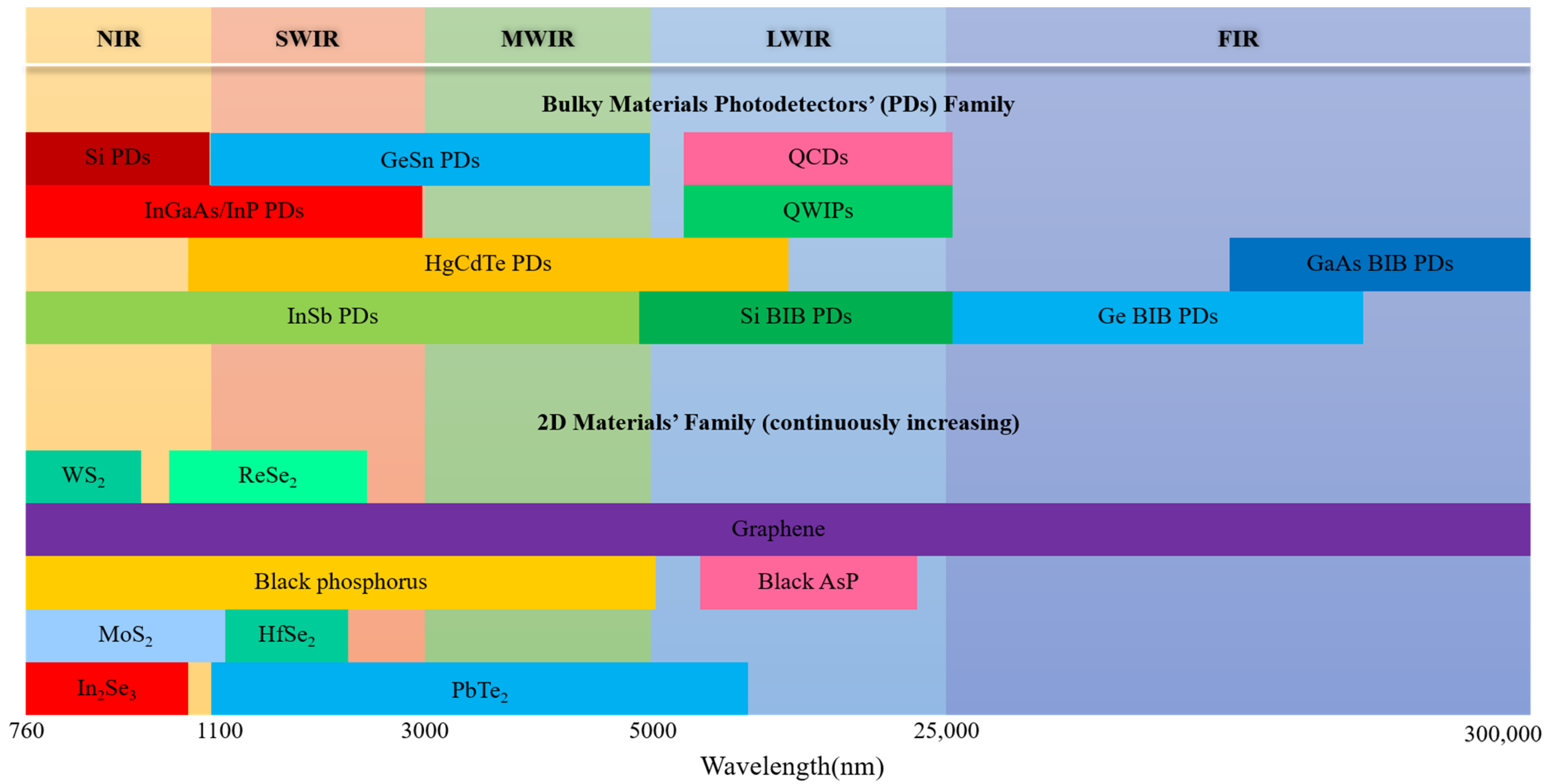



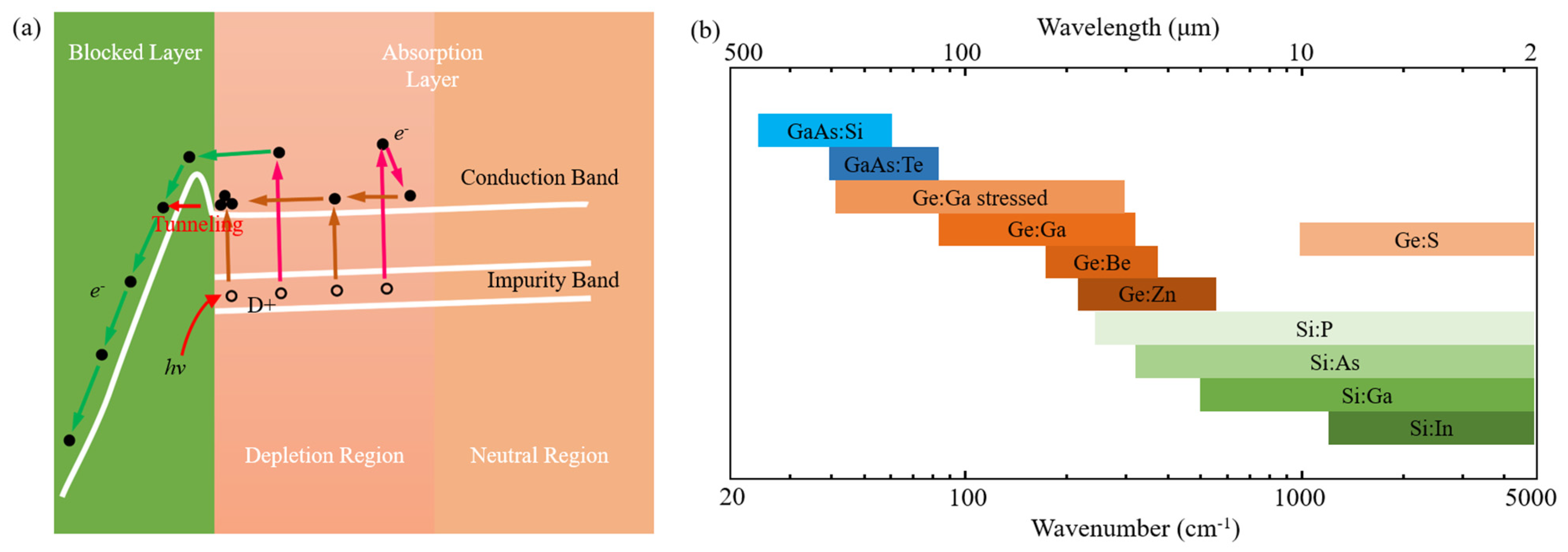
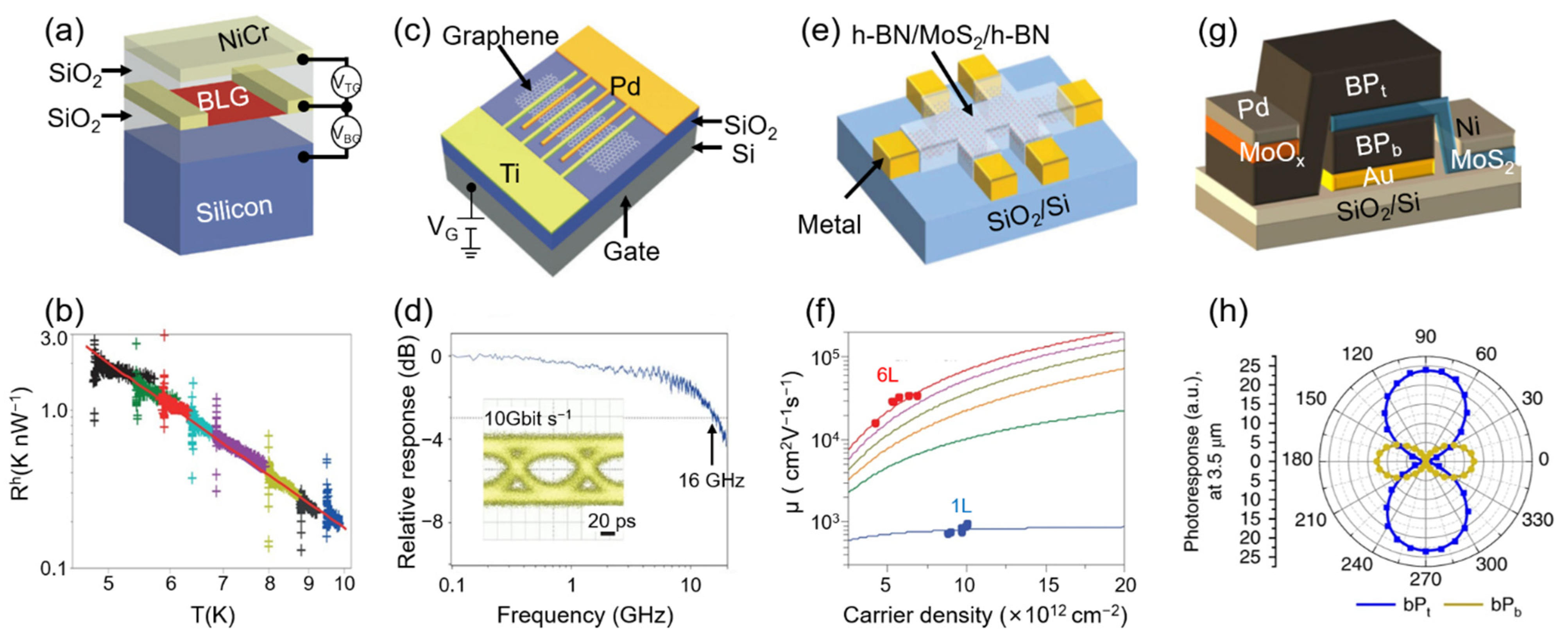
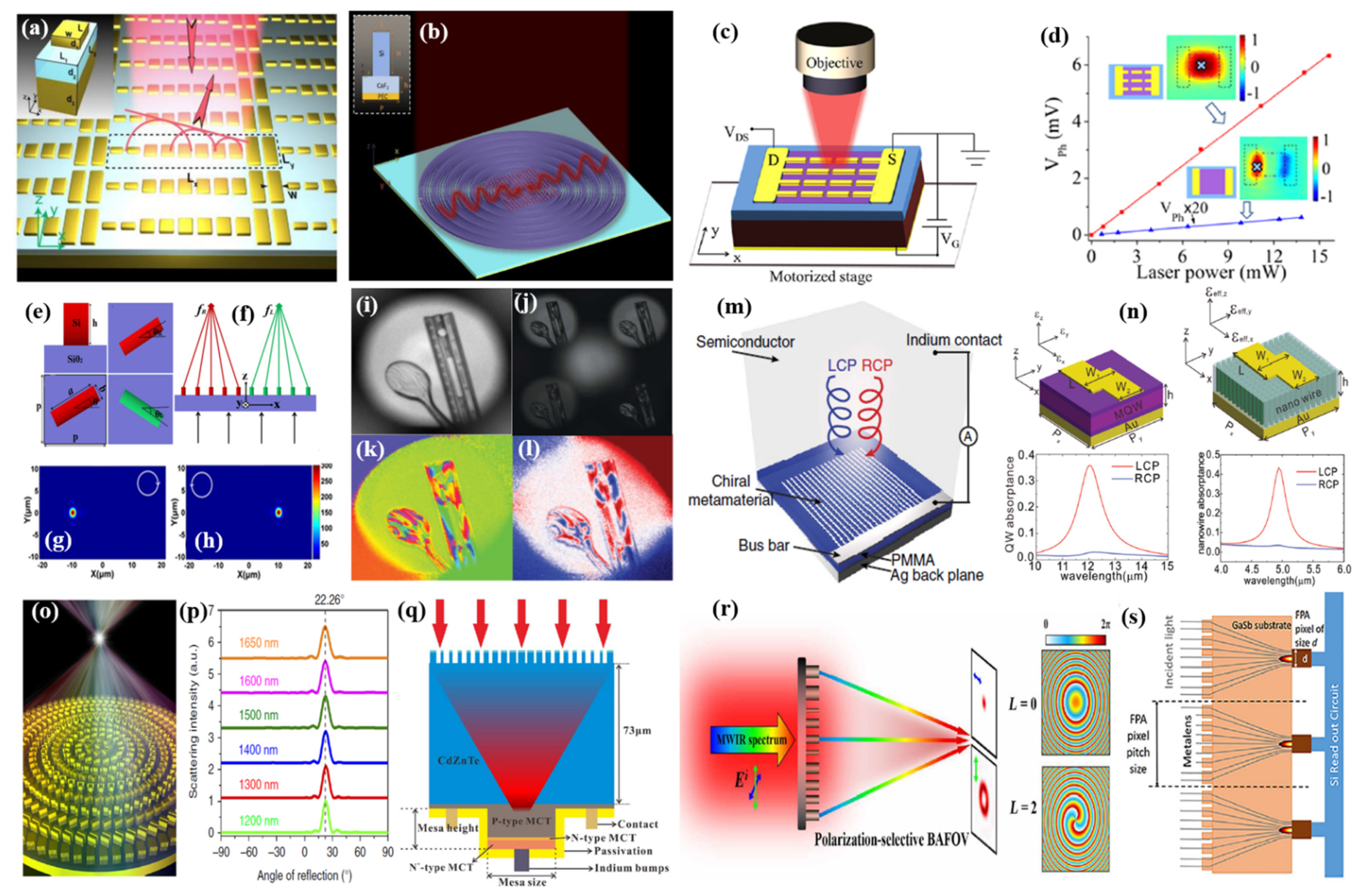
| Structures | Institutes | AS, UTC | SITP, CAS | XenICs | Sofradir |
|---|---|---|---|---|---|
 Standard | Arrays | 2048 × 1 320 × 256 640 × 512 | 512 × 1 1024 × 1 320 × 256 640 × 512 4000 × 128 | 512 × 1 1024 × 1 2048 × 1 320 × 256 640 × 512 | 640 × 512 |
| DC or DCD | 30 fA | <5 nA·cm−2 | 15~40 fA | 30 fA | |
| D* or QE | 2.5 × 1013 Jones | 5 × 1012 Jones | 80% | 70% | |
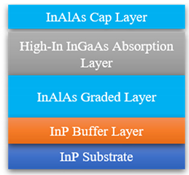 Long-wave Extended | Arrays | 256 × 1 512 × 1 1024 × 1 | 640 × 1 512 × 256 1024 × 256 | ||
| DC or DCD | 10~100 nA | <10 nA·cm−2 | |||
| D* or QE | >50% | 5 × 1011 Jones | |||
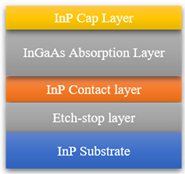 Visible Extended | Arrays | 320 × 240 640 × 512 1280 × 1024 | 320 × 256 640 × 512 | ||
| DC or DCD | <7.2 nA·cm−2 | 15~40 fA | |||
| D* or QE | 2.9 × 1013 Jones | 80% |
| Institutes | Detectors | Response Range | QE or D* or Responsivity | Dark Current | Array or Element |
|---|---|---|---|---|---|
| DRS (WISE) | Si:As | 5~28 μm | >70% | 10−14 A | 1024 × 1024 |
| Raytheon (JWST) | Si:As | 5~28 μm | >70% | 10−14 A | 1024 × 1024 |
| Zhejiang University | Si:P | ~40 μm | 1.6 × 1011 Jones | 10−9 A | Element |
| Ge:P | 40~130 μm | 1.3 × 1013 Jones | 10−9 A | Element | |
| Ge:S | 2~10 μm | 9.7 × 1010 Jones | 10−9 A | Element | |
| SITP, CAS | Si:P | 2.5~40 μm | 5.6 × 1012~1013 Jones | 10−12 A | Element |
| Si:As | 2.5~37 μm | 5. 3 × 1013 Jones | 10−12 A | Element | |
| The 50th Research Institute, CETC | Si:P | 7.4~46.3 μm | 15.4 A/W | 10−12~10−9 A | Element |
Publisher’s Note: MDPI stays neutral with regard to jurisdictional claims in published maps and institutional affiliations. |
© 2022 by the authors. Licensee MDPI, Basel, Switzerland. This article is an open access article distributed under the terms and conditions of the Creative Commons Attribution (CC BY) license (https://creativecommons.org/licenses/by/4.0/).
Share and Cite
Chen, J.; Wang, J.; Li, X.; Chen, J.; Yu, F.; He, J.; Wang, J.; Zhao, Z.; Li, G.; Chen, X.; et al. Recent Progress in Improving the Performance of Infrared Photodetectors via Optical Field Manipulations. Sensors 2022, 22, 677. https://doi.org/10.3390/s22020677
Chen J, Wang J, Li X, Chen J, Yu F, He J, Wang J, Zhao Z, Li G, Chen X, et al. Recent Progress in Improving the Performance of Infrared Photodetectors via Optical Field Manipulations. Sensors. 2022; 22(2):677. https://doi.org/10.3390/s22020677
Chicago/Turabian StyleChen, Jian, Jiuxu Wang, Xin Li, Jin Chen, Feilong Yu, Jiale He, Jian Wang, Zengyue Zhao, Guanhai Li, Xiaoshuang Chen, and et al. 2022. "Recent Progress in Improving the Performance of Infrared Photodetectors via Optical Field Manipulations" Sensors 22, no. 2: 677. https://doi.org/10.3390/s22020677
APA StyleChen, J., Wang, J., Li, X., Chen, J., Yu, F., He, J., Wang, J., Zhao, Z., Li, G., Chen, X., & Lu, W. (2022). Recent Progress in Improving the Performance of Infrared Photodetectors via Optical Field Manipulations. Sensors, 22(2), 677. https://doi.org/10.3390/s22020677









